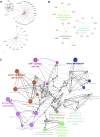Integrative Analyses of Genes Associated With Right Ventricular Cardiomyopathy Induced by Tricuspid Regurgitation
- PMID: 34603374
- PMCID: PMC8485137
- DOI: 10.3389/fgene.2021.708275
Integrative Analyses of Genes Associated With Right Ventricular Cardiomyopathy Induced by Tricuspid Regurgitation
Abstract
Tricuspid regurgitation (TR) induces right ventricular cardiomyopathy, a common heart disease, and eventually leads to severe heart failure and serious clinical complications. Accumulating evidence shows that long non-coding RNAs (lncRNAs) are involved in the pathological process of a variety of cardiovascular diseases. However, the regulatory mechanisms and functional roles of RNA interactions in TR-induced right ventricular cardiomyopathy are still unclear. Accordingly, we performed integrative analyses of genes associated with right ventricular cardiomyopathy induced by TR to study the roles of lncRNAs in the pathogenesis of this disease. In this study, we used high-throughput sequencing data of tissue samples from nine clinical cases of right ventricular myocardial cardiomyopathy induced by TR and nine controls with normal right ventricular myocardium from the Genotype-Tissue Expression database. We identified differentially expressed lncRNAs and constructed a protein-protein interaction and lncRNA-messenger RNA (mRNA) co-expression network. Furthermore, we determined hub lncRNA-mRNA modules related to right ventricular myocardial disease induced by TR and constructed a competitive endogenous RNA network for TR-induced right ventricular myocardial disease by integrating the interaction of lncRNA-miRNA-mRNA. In addition, we analyzed the immune infiltration using integrated data and the correlation of each immune-related gene with key genes of the integrated expression matrix. The present study identified 648 differentially expressed mRNAs, 201 differentially expressed miRNAs, and 163 differentially expressed lncRNAs. Protein-protein interaction network analysis confirmed that ADRA1A, AVPR1B, OPN4, IL-1B, IL-1A, CXCL4, ADCY2, CXCL12, GNB4, CCL20, CXCL8, and CXCL1 were hub genes. CTD-2314B22.3, hsa-miR-653-5p, and KIF17ceRNA; SRGAP3-AS2, hsa-miR-539-5p, and SHANK1; CERS6-AS1, hsa-miR-497-5p, and OPN4; INTS6-AS1, hsa-miR-4262, and NEURL1B; TTN-AS1, hsa-miR-376b-3p, and TRPM5; and DLX6-AS1, hsa-miR-346, and BIRC7 axes were obtained by constructing the ceRNA networks. Through the immune infiltration analysis, we found that the proportion of CD4 and CD8 T cells was about 20%, and the proportion of fibroblasts and endothelial cells was high. Our findings provide some insights into the mechanisms of RNA interaction in TR-induced right ventricular cardiomyopathy and suggest that lncRNAs are a potential therapeutic target for treating right ventricular myocardial disease induced by TR.
Keywords: immune cell infiltration; lncrna-mRNA co-expression network; long non-coding RNAs; right ventricular cardiomyopathy; tricuspid regurgitation.
Copyright © 2021 Tian, Yang, Ke, Yang, Zhong, Wang and Huang.
Conflict of interest statement
The authors declare that the research was conducted in the absence of any commercial or financial relationships that could be construed as a potential conflict of interest.
Figures









Similar articles
-
Integrated analysis of long noncoding RNA-associated competing endogenous RNA network in periodontitis.J Periodontal Res. 2018 Aug;53(4):495-505. doi: 10.1111/jre.12539. Epub 2018 Mar 8. J Periodontal Res. 2018. PMID: 29516510
-
A ceRNA network of BBOX1-AS1-hsa-miR-125b-5p/hsa-miR-125a-5p-CDKN2A shows prognostic value in cervical cancer.Taiwan J Obstet Gynecol. 2021 Mar;60(2):253-261. doi: 10.1016/j.tjog.2020.12.006. Taiwan J Obstet Gynecol. 2021. PMID: 33678324
-
Identification of Potential lncRNAs and miRNAs as Diagnostic Biomarkers for Papillary Thyroid Carcinoma Based on Machine Learning.Int J Endocrinol. 2021 Jul 21;2021:3984463. doi: 10.1155/2021/3984463. eCollection 2021. Int J Endocrinol. 2021. PMID: 34335744 Free PMC article.
-
The Emerging Role of Non-Coding RNAs in Pituitary Gland Tumors and Meningioma.Cancers (Basel). 2021 Nov 28;13(23):5987. doi: 10.3390/cancers13235987. Cancers (Basel). 2021. PMID: 34885097 Free PMC article. Review.
-
A Review on the Expression Pattern of Non-coding RNAs in Patients With Schizophrenia: With a Special Focus on Peripheral Blood as a Source of Expression Analysis.Front Psychiatry. 2021 Jun 18;12:640463. doi: 10.3389/fpsyt.2021.640463. eCollection 2021. Front Psychiatry. 2021. PMID: 34220567 Free PMC article.
Cited by
-
Antisense-mediated regulation of exon usage in the elastic spring region of Titin modulates sarcomere function.Cardiovasc Res. 2025 May 6;121(4):629-642. doi: 10.1093/cvr/cvaf037. Cardiovasc Res. 2025. PMID: 40042822 Free PMC article.
-
Paired Box 5-Induced LINC00467 Upregulation Promotes the Progression of Laryngeal Squamous Cell Cancer by Triggering the MicroRNA-4735-3p/TNF Alpha-Induced Protein 3 Pathway.Mol Biotechnol. 2023 Apr;65(4):655-667. doi: 10.1007/s12033-022-00564-3. Epub 2022 Oct 10. Mol Biotechnol. 2023. PMID: 36214976
-
Right Ventricle and Epigenetics: A Systematic Review.Cells. 2023 Nov 23;12(23):2693. doi: 10.3390/cells12232693. Cells. 2023. PMID: 38067121 Free PMC article.
-
Long noncoding RNA CERS6-AS1 modulates glucose metabolism and tumor progression in hepatocellular carcinoma by promoting the MDM2/p53 signaling pathway.Cell Death Discov. 2022 Aug 4;8(1):348. doi: 10.1038/s41420-022-01150-x. Cell Death Discov. 2022. PMID: 35927226 Free PMC article.
-
Cellular and Molecular Mechanisms Underlying Tricuspid Valve Development and Disease.J Clin Med. 2023 May 14;12(10):3454. doi: 10.3390/jcm12103454. J Clin Med. 2023. PMID: 37240563 Free PMC article. Review.
References
LinkOut - more resources
Full Text Sources
Research Materials
Miscellaneous

